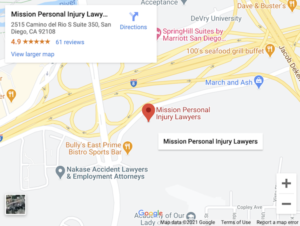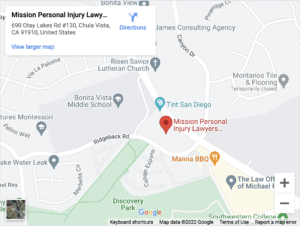
If you are hurt in a car accident, whether you have no-fault or at-fault car insurance will determine whom you need to make your claim against as well as the process that is involved. Understanding the insurance policies that are in place can help you identify your possible avenues of recovery.
Table of Contents
What Is At-Fault Insurance?
At-fault, or tort insurance, is what most people think of after a car accident. Drivers are required to maintain minimum amounts of liability coverage by state law. This insurance covers the damages the insured causes to the other driver. For example, in California, the minimum liability insurance requirements are:
- $15,000 for bodily injury per person
- $30,000 for bodily injury per accident
- $5,000 for property damage
This insurance covers the other driver’s and passenger’s medical bills and other expenses. These are just the minimum amounts of insurance required under state law; drivers can purchase additional liability coverage.
When you get in an accident in an at-fault state and the other driver is at fault, you generally make a claim with the at-fault party’s car insurance provider.
Most states are at-fault insurance states, including California.
What Is No-Fault Insurance?
In no-fault insurance states, drivers are required to purchase Personal Injury Protection (PIP) coverage. This insurance generally pays for an injured person’s medical expenses.
If you are a driver in a no-fault state, you will turn to your own insurance for coverage. Generally, no-fault insurance covers medical expenses up to the policy limits. Any property damage claim would generally be filed with the at-fault party’s liability insurance. In some no-fault states, victims can still pursue compensation from the at-fault party, but only if their injuries were especially severe.
Proponents of no-fault insurance say that this type of insurance model prevents frivolous lawsuits from clogging up the courts and increasing insurance costs. However, no-fault insurance is sometimes more expensive than insurance in fault-based states because fault is not a determining factor in coverage. Additionally, car accident victims can pay for their needed medical expenses sooner with no-fault insurance.
Which States Use No-Fault Insurance?
According to Bankrate, the following states have a no-fault insurance system:
- Florida
- Hawaii
- Kansas
- Kentucky
- Massachusetts
- Michigan
- Minnesota
- New Jersey
- New York
- North Dakota
- Pennsylvania
- Utah
While these states may use no-fault insurance, each state has its own approach and unique rules. For example, Pennsylvania is a “choice” state, meaning that drivers can choose whether to purchase insurance that is primarily no-fault or at-fault.
What Are the Differences Between No-Fault and At-Fault Insurance?
Besides determining who pays out on insurance claims and when, another important difference between no-fault and at-fault insurance is that the former can limit a person’s right to sue. State law may indicate that a person can only sue the at-fault party if they suffered a serious injury or losses in excess of their no-fault insurance coverage. In these situations, the victim would need to establish fault.
Additionally, no-fault insurance is generally limited in the expenses it pays. For example, if may only pay a portion of medical expenses and lost wages, up to the policy limits. It might not pay for unreimbursed expenses, pain and suffering, or incidental costs.
Add-On Coverage
Further complicating the matter, some at-fault states allow insured individuals to purchase additional insurance that covers their losses just as it would in no-fault states. For example, they may be able to purchase MedPay insurance that covers their medical expenses following a car accident, regardless of who is at fault.
Determining Fault in a Car Accident
If you need to file a property claim against an at-fault party or otherwise need to establish fault, you may need evidence, such as:
- Police reports – In addition to listing the other driver’s contact and insurance information, police accident reports may contain initial determinations of fault and information regarding whether the other driver received a traffic citation.
- Traffic laws – Many car accidents occur when drivers fail to yield the right of way. You may be able to show fault based on the position of the vehicles and the location of the damage. For example, in a T-bone crash, the driver turning left in front of oncoming traffic may be found at fault for failing to yield the right-of-way.
- Photos – Photos of the accident scene can help indicate where the point of impact is. They can also capture skid marks and other relevant evidence.
- Video – Videos may be available from traffic cameras, dash cameras, or surveillance footage. These videos may show the accident itself or the moments leading up to it.
- Medical records – Your medical records may help show your injuries and how they are consistent with being in certain positions at the time of the accident.
- Witness statements – Objective witness statements can also serve to help the accident victim establish liability.
Your car accident lawyer can investigate the accident, gather evidence, and prepare a demand letter for fair compensation if you were injured in a car accident that was not your fault.
The Need for Legal Assistance Following an Accident
Because every state has its own unique rules, it is important that you understand the rules where you are living, as well as those where you travel. An experienced San Diego car accident attorney at Mission Personal Injury Lawyers can explain your legal rights and options following a car accident. Consider contacting a lawyer to learn more today by calling (619) 777-5555.


